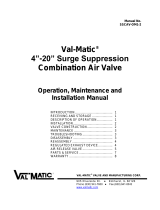
Type 92S
12
10. Install the diaphragm gasket. Install both
diaphragms with their raised preformed centers
facing toward the spring case.
11. Lubricate the upper spring seat and the exposed
threads of the adjusting screw. Install the lower
spring seat (key 11, Types 6492H and 6492HT
pilots only) or diaphragm plate assembly (key 24,
Type 6492L pilot only), control spring (key 12),
upper spring seat (key 13), and spring case
(key 14). Insert and tighten the cap screws
(key 17) to between 12 and 18 foot•pounds /
16 and 24 N•m of torque, using a crisscross
bolting pattern.
12. When pilot maintenance is complete, refer to
the Startup section to put the regulator back in
operation and adjust the pressure setting.
Type 92S Main Valve
Perform these procedures if replacing the piston(s),
cylinder(s), stem(s), seals, valve plug, or seat ring.
All key numbers are referenced in Figure 5 except
where otherwise indicated. Instructions are given for
complete disassembly and assembly. Disassemble
the main valve only as far as necessary to complete
the required maintenance. Then, begin the assembly
procedure at the appropriate step.
Note
The regulator may remain in the pipeline
during maintenance procedures unless
the main valve body is replaced or
removed for repairs.
Whenever a gasket seal is disturbed by
removing or shifting gasketed parts, a
new gasket should be installed upon
reassembly. This is necessary to ensure
a good gasket seal.
Disassembly
1. Disconnect all tubing and remove the pilot from the
main valve.
2. Remove the cap screws (key 3, not shown) from
a cast iron body, or stud nuts (key 4) from a steel
body, and lift off the body ange.
3. For NPS 1, 1-1/2, and 2 / DN 25, 40, and
50 body sizes, remove the top cylinder (key 17),
and pull out the top piston with attached stem
and other parts. Remove the hex nut (key 41),
lockwasher (key 40), top ring retainer (key 26), and
top piston ring (key 25) from the top piston (key 24).
4. For NPS 1, 1-1/2, and 2 / DN 25, 40, and
50 body sizes, lift off the cylinder spacer (key 21),
and remove the stem seal retainer (key 23) and
stem seal (key 22) from the spacer.
5. Remove the cylinder (key 17), piston (key 24) with
attached parts, and spiral wound gasket (key 8).
6. Remove the cotter pin (key 16, NPS 1, 1-1/2,
and 2 / DN 25, 40, and 50 body sizes only), stem
nut (key 15), lower stem (key 9) with hex head,
valve plug (key 6), piston ring retainer (key 26),
piston ring (key 25), bottom piston ring retainer
(key 26, applicable for all sizes), piston (key 24),
spring (key 12), piston spacer (key 11), cage
(key 5), and seat ring (key 7).
7. If Noise Attenuation is used, remove the plug
spacer (key 33, NPS 2 / DN 50 body size only),
deector (key 36, NPS 2 / DN 50 body size only),
and screen (key 37).
8. Either remove the retaining ring (key 14), or
remove the spring seat, washer, and O-ring
(keys 32, 34, and 38), if it is necessary to remove
the bafe (key 13).
Assembly
1. Inspect and replace parts as necessary, making
sure that the hollow passage in the upper stem
(key 20, NPS 1, 1-1/2, and 2 / DN 25, 40, and
50 body sizes only) is free from debris.
2. Install a spiral wound gasket (key 8) into the body
(key 1).
3. When installing a new valve plug and/or a new
seat ring, or lower stem, lap the seating surfaces
together outside the body. Use a commercial lapping
compound or a mixture of solidied vegetable oil and
600-grit or ner silicon carbide or aluminum oxide.
Note
If a Noise Attenuation is used, install the
size only) where appropriate in the
following step.
4. Secure the hex head at the lower stem (key 9)
in a vise. Install the valve plug (key 6), seat ring
(key 7) and cage (key 5).
install the bafe (key 13) and the
retaining ring (key 14). Then, install the piston
spacer (key 11) down through the bafe until it
makes contact with the valve plug.





















